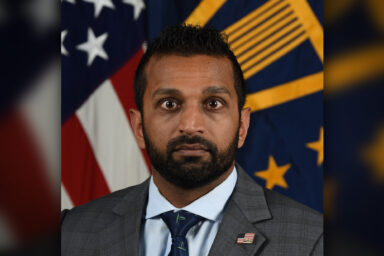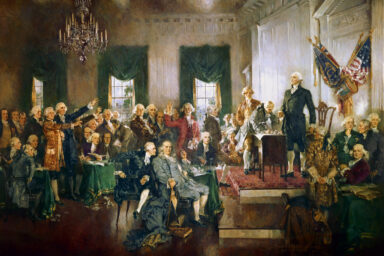No need to watch this stuff, because we did it for you.
Nixon-era commerce secretary and Watergate figure Maurice Stans never knew it, but he provided the Republican senators now trying President Donald Trump with what we might call an operating principle: “I don’t want to know, and you don’t want to know.”
On January 21, 53 US senators voted consistently in favor of holding a trial with as little evidence and as few witnesses as possible. Eleven times, all 53 Republican senators/jurors voted to reject amendments to the procedural rules designed to open the trial to documentary evidence and witness testimony currently blocked by the president’s refusal to comply with subpoenas or allow executive branch employees to testify before the House.
It’s judicially unusual for a jury to be deciding what evidence it will hear, but this is an impeachment trial, so all standard judicial procedures are subject to adjustment by a majority vote. That’s what the Constitution provides in Article I, section 3: “The Senate shall have the sole power to try all Impeachments.”
The Constitution adds that, in an impeachment trial of the president, the senators shall be sworn in as jurors, that the chief justice of the Supreme Court shall preside, and conviction requires a two-thirds majority of the Senate. That is the sum total of constitutional guidance for an impeachment trial. Other guidance comes from 18th century commentary, two centuries of precedent, current legal analysis, and the exercise of raw political power.
All of those factors were on display January 21, when the Senate jury considered what rules would govern the rest of the trial. The rules were proposed by Senate Majority Leader Mitch McConnell (R-KY), who has acknowledged coordinating with the White House on trial tactics to reach the strategic goal of acquitting the president with as much credibility and as quickly as possible.
To that end, McConnell had presented Senate Resolution 483, outlining trial procedures in three pages that make it possible for the Senate to get the trial over as quickly and insubstantially as possible. Each side is allowed three days to make its presentation, then vote whether or not to debate the possibility of calling witnesses or asking for further evidence. Failing that, the Senate will vote on each article of impeachment.
As presented, S. Res. 483 offered a framework within which the Senate could effectively run a kangaroo court without checks or balances. Attempting to head off that possibility, Minority Leader Chuck Schumer (D-NY) offered a series of amendments seeking to open up the Senate trial to evidence and witnesses that the president had effectively withheld from the House going back to April 2019. Each of Schumer’s amendments was designed to make a chink in the president’s stonewall that prevented the House from fully developing the case that Trump used the power of the presidency for personal gain when he attempted to use congressionally approved military aid to force the president of Ukraine to publicly announce an investigation that could damage Joe Biden’s presidential candidacy.
-
- Amendment #1 sought to subpoena all relevant records withheld by the White House and the National Security Council (NSC) relating to Ukraine and the withheld aid. Rep. Zoe Lofgren (D-CA) reminded senators that the issue had been decided 9-0 by the Supreme Court in US v. Nixon (1974), when the court ruled that the president could not withhold tapes relevant to impeachment proceedings. With respect to the material withheld by Trump, Lofgren argued that it made more sense to review the evidence before hearing arguments, as S. Res. 483 requires: “We don’t know with certainty what the documents will say. We simply want the truth. So do the American people. They want the truth.” The president’s lawyers ignored the argument and asserted that the House had no procedural right to the evidence. McConnell moved to table the amendment. With all Republicans voting to table, the Senate killed the amendment 53–47.
- Amendment #2 sought all relevant documents withheld by the State Department, by order of the president. Rep. Val Demings (D-FL) argued that “the president sought to conceal evidence of misconduct. He did so by ordering his entire administration, every office, every agency, every official, to defy every subpoena that was served in the House impeachment inquiry. No president in history has ever done anything like this.” The president’s lawyers didn’t challenge that assertion, but claimed none of the subpoenas was legally valid. Again McConnell moved to table and Senate Republicans killed the amendment 53–47.
- Amendment #3 sought all relevant documents withheld by the Office of Management and Budget (OMB) in withholding the lawfully approved aid for Ukraine. The Government Accountability Office (GAO) has found that the OMB hold on the Ukraine aid was a violation of law. McConnell moved to table and Senate Republicans killed the amendment 53–47.
- Amendment #4 sought to call Mick Mulvaney as a witness. Mulvaney, as head of OMB and chief of staff to the president, was at the center of efforts to withhold Ukraine aid. OMB defied a House subpoena for evidence. The president’s lawyers ignored the charge and said Ukraine got the aid eventually. McConnell again moved to table and the Republican majority killed the amendment 53–47.
- Amendment #5 sought all relevant documents withheld by the Department of Defense, which had been concerned that Ukraine wasn’t getting legitimate aid when it was fighting Russian-backed proxies in a civil war in its eastern region. The president’s lawyers said the aid wasn’t withheld long enough for Ukraine to notice. McConnell moved to table and Senate Republicans killed the amendment 53–47. McConnell then requested that Schumer agree to a vote on all the rest of his amendments as a bloc, since it was almost 10 PM (the session had begun at 1 PM). Schumer refused, saying, “We will not back off.”
- Amendment #6 sought the testimony of two other officials active in handling and hiding the Ukraine aid hold: Robert Blair, a senior aide to Mulvaney, and Michael Duffey, a political appointee at OMB who had been at the Pentagon. Both men had been ordered not to testify in the House. McConnell moved to table, Republican senators/jurors killed the amendment 53–47.
- Amendment #7 sought a procedural rule to assure that all evidence the Senate sought by subpoena included all relevant related documents. Rep. Adam Schiff (D-CA) explained that this was a way to keep the president from cherry-picking evidence or from redacting incriminating parts of documents, as he had already done with some redacted documents sent to the House. The president’s lawyers didn’t dispute this but said the subpoenas had been invalid. Republican senators tabled the amendment 53–47.
- Amendment #8 sought to subpoena former NSC head John Bolton, who had refused to testify in the House. Bolton referred to the Ukraine shenanigans, in which he was not involved, as a “drug deal” concocted by Trump operatives. Rep. Jerrold Nadler (D-NY) accused the president’s lawyers of arguing nothing but process while offering no evidence to exonerate the president. “They lie and lie and lie,” Nadler said, raising the question of whether the Senate will be “complicit… part of a cover-up.” A vote against calling Bolton, according to Nadler, would be a vote for cover-up, a vote against a fair trial, a vote against the US, “a treacherous vote.” The president’s lawyers responded heatedly, accusing Nadler of lying. Nadler called a presidential lawyer a liar and cited an example. Nadler said, “No president ever claimed the right to stonewall the Congress on everything … These facts are undeniable.” Chief Justice John Roberts, presiding, chided both sides for their elevated rhetoric.
- Amendment #9 sought a separate Senate vote on whether to hear any particular witness proposed by either side. The president’s lawyers misrepresented the rules, saying they would vote on witnesses after both sides present their case. The rules provide only for a vote on whether to debate having witnesses. A vote against debating witnesses would preclude calling any witnesses. “The veneer is completely gone now,” said Schiff, telling the Senate that voting down this amendment would mean that the senators/jurors have no interest in assessing the credibility of witnesses for themselves. Republican senators/jurors voted to table the amendment 53–47.
- Amendment #10 sought to allow sufficient time for Senators to file written responses to motions already filed with the Senate. The extra time requested was 24 hours. Senate Republicans rejected the request 52–48. Sen. Susan Collins (R-ME) voted with the Democrats.
- Amendment #11 sought to allow Roberts to rule on the probative value of any witness or document subpoenaed by either side. Schiff argued that this would allow for a process that looks more like a fair trial. Under the amendment, any senator could move for specific evidence and the chief justice would rule on its relevance. The Senate would retain the power to overrule the chief justice. The president’s lawyers opposed the amendment, saying the Senate should have total control. “We trust the chief justice,” Schiff said, suggesting that his colleagues don’t. The result was the same, with everyone back on the reservation, Republican senators/jurors tabled the amendment 53–47.
By this time it was after 1:30 AM and most of America had likely missed most of what turned out to be an unusually instructive show. Despite the locked-down vote of the majority, the House managers had used something like eight hours to present large, important parts of their case as they argued for the various amendments. They achieved something like an opening argument to the jury, an argument that was factually unrebutted for the most part. The president’s lawyers were fighting to control the process but the Senate was also hearing the outline of the case. Whether it will matter remains to be seen, and for now the kangaroos have a victory.
Related front page panorama photo credit: Adapted by WhoWhatWhy from C-SPAN.



